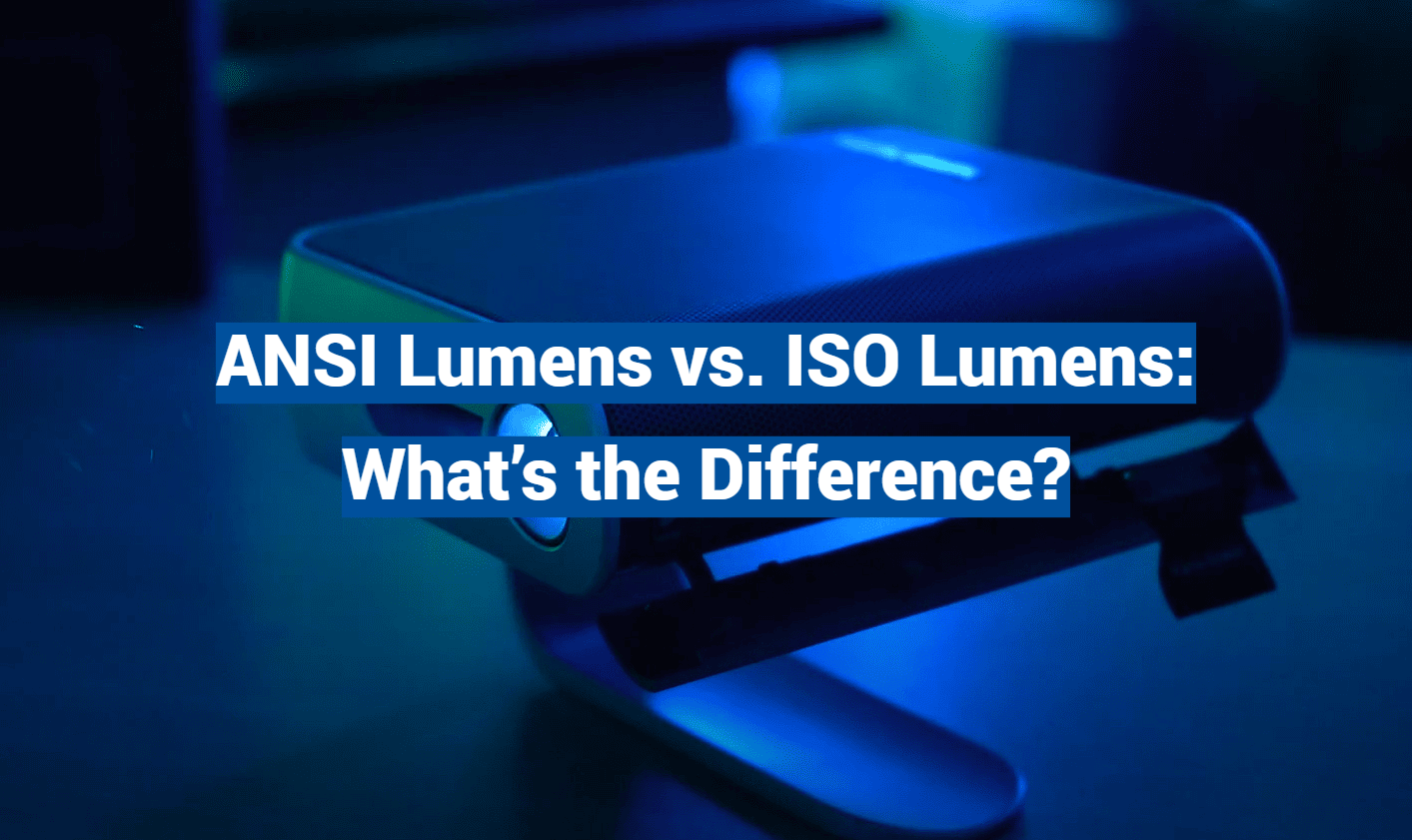If you’re in the market for a new projector, you’ve probably come across the terms ANSI and ISO lumens. But what do they really mean? In this blog post, we’ll explain the difference between the two and help you understand which one is right for your needs.
ANSI Lumens: What They Are and Why They Are Needed
When it comes to buying a projector, there are many factors to consider. One of the most important of these factors is the projector’s brightness, which is measured in ANSI lumens. Understanding ANSI lumens is crucial as it determines the projector’s picture quality. In this part of our blog post, we will explore what ANSI lumens are and why they are needed.

ANSI lumens, also known as American National Standards Institute lumens, measure the brightness of a projector. This is a standardized system of measurement that allows customers to accurately compare the brightness of different projectors. [1]
Projectors with high ANSI lumens ratings are ideal for large venues and bright rooms, while those with lower ANSI lumens ratings are better suited for smaller rooms or darker environments. For instance, a small conference room may require a projector with 3,000 ANSI lumens or less, while a large auditorium may require a projector with 5,000 ANSI lumens or more.
It is worth noting that the higher the ANSI lumens, the more expensive the projector will be. This means that it is essential to know how much brightness is needed for the environment the projector is intended for before making a purchase. [1]
While the ANSI lumens rating is important, it is not the only factor to consider when selecting a projector. Brightness alone cannot guarantee the picture quality. Contrast ratio, resolution, and color reproduction are also important factors that contribute to the picture quality.
Another essential point to think about is the throw distance, that is the distance between the projection screen and the projector. The throw distance determines the size of the image which the projector can display clearly. A projector with a short throw distance produces a big image even in a small room, while a projector with a long throw distance is ideal for larger rooms or halls.
Understanding ANSI lumens is essential when selecting a projector as it determines the brightness of the projector. It is highly important to pay attention to the environment in which the projector will be used before looking for ANSI lumens ratings. High ANSI lumens ratings are not always the best option for every environment. It is also crucial not to ignore other factors such as throw distance, resolution, contrast ratio, and color reproduction, which all play a role in determining the picture quality. Taking all of these factors into account will help you select the projector best suited to your needs.

ISO Lumens: What They Are and Why They Are Needed
You might have heard about ISO Lumens before, but what are they and why are they important? ISO lumens are a measure of the brightness of a projector. In simpler terms, it determines how bright the image will appear on the screen. Understanding ISO Lumens is vital if you’re considering purchasing a projector or setting up a presentation. Here, we will discuss what ISO Lumens are and why they are essential.
Firstly, let’s understand what ISO Lumen means. Lumen is a measurement of the amount of light that a projector generates, and ISO is a standardized method for measuring it. The ISO Lumen is basically the amount of light that is emitted from a projector. For example, a projector with 2000 ISO Lumens means that it emits 2000 lumens of light onto the screen. The higher the ISO Lumens, the brighter the image appears on the screen. [2]
Now you might be thinking, why are ISO Lumens so important? Well, the brightness of your image plays a critical role in delivering a presentation of high quality. If the image is too dim, it can be challenging to read and understand, and your audience might lose interest. On the other hand, if the brightness is too high, it can put a lot of strain on your eyes, which can lead to headaches and eye fatigue. Therefore, it’s crucial to keep a balance between brightness and darkness.
It’s also important to remember that the lighting conditions in the room can significantly affect the ISO Lumens. For example, if your room is dim, you would need a projector with higher ISO Lumens to create a bright image. On the other hand, if your room is bright, you can get away with a projector with lower ISO Lumens. Therefore, it’s important to consider the lighting conditions of your room before making a purchase.
When it comes to purchasing a projector, most manufacturers advertise their projectors based on ANSI Lumens, which is not the same as ISO Lumens. ANSI Lumen is a different method for measuring brightness, and it tends to give higher values than ISO Lumen. That’s because ANSI Lumen measures brightness at a specific point in the center of the projected image, whereas ISO Lumen measures brightness across the entire image. Therefore, it’s essential to keep this in mind while making a decision.
To sum up, ISO Lumens are a crucial aspect to consider while purchasing a projector or setting up a presentation. It plays a vital role in delivering a high-quality presentation. Now that you know the importance of ISO Lumens, you can make an informed decision while purchasing a projector. Always keep in mind the lighting conditions of your room, and don’t forget that ANSI Lumen is not the same as ISO Lumen. A projector with the right ISO Lumens can make a significant difference in your presentation.

ANSI Lumens: Benefits and Drawbacks
When buying a new projector, there are several things to consider – image quality, contrast ratio, and connectivity options. But one of the most important things to remember about is the level of brightness of your projector. The brightness of a projector is measured in ANSI lumens, which stands for American National Standards Institute lumens. In this part of our blog post, we’ll discuss the benefits and drawbacks of ANSI lumens, so you can make an informed decision when choosing your projector.
The primary advantage of high ANSI lumens is that they allow you to project clear and bright images even in well-lit rooms. Low-ANSI-lumen projectors might seem less expensive, but the image they produce is often washed out or not visible in rooms with ambient light. This is especially crucial when the projector is needed for presentations, whether at work or school, or for movie watching outdoors.
One of the disadvantages of high ANSI lumens is that the brighter the projector, the more power it consumes and the shorter its lifespan. After all, the brighter the projector, the more energy it uses. This can lead to higher energy costs, replacement costs, and maintenance. So you must find the balance between the level of brightness you need and the budget that you have.
Another disadvantage of high ANSI lumens is that they can cause harm to your eyes if not used responsibly. Although the risk of eye damage is low when using a projector, it is always better to play it safe and follow the recommended guidelines. If you or someone you know feels like there might be an issue, it’s better to speak with an optometrist.
The benefits of low ANSI lumens, comparatively, include, energy efficiency, which reduces operating costs and energy consumption. Additionally, a low lumen projector’s bulb is expected to last longer, reducing replacement costs.
But, the drawbacks of low ANSI lumens are that these projectors are not very reliable in bright light, and the shading levels with less lumen projectors are not up to the mark, which can reduce the image quality.
To sum it up, before buying a projector, it is essential to weigh the advantages and disadvantages of ANSI lumens. Choose the correct ANSI lumen level to fulfill your requirements, as well as providing a long-lasting bulb life with minimum maintenance requirements, to avoid overspending on energy and bulb replacement costs. Just keep in mind, safety, efficiency, effectiveness, cost-effectiveness, and the image quality, so that you can make a sound purchasing decision and have a projector that best fits your needs!

ISO Lumens: Benefits and Drawbacks
Projectors have become a staple technology in today’s offices and homes. From presentations to movie nights, projectors have come a long way and now offer more features than ever before. ISO lumens are a preferred standard when it comes to measuring projector brightness, and in this part, we offer you to discuss its benefits and drawbacks.
ISO lumens – What are they?
Though it might sound technical, ISO lumens are simply a standard measurement of brightness. ISO stands for International Organization for Standardization, which is a body that sets standards for various products. In the case of projectors, ISO lumens is a standard to which projector manufacturers have to adhere when measuring projector brightness. This ensures that the brightness levels advertised by manufacturers are consistent and reliable.
Benefits of using ISO lumens
One of the most significant benefits of using ISO lumens is the reliability and accuracy of the brightness measurement. When you’re shopping for a projector, the advertised lumens may not always match the actual brightness of the projector. However, with ISO lumens, you can be sure that the brightness advertised is genuine, and you have the possibility to compare the brightness of different projectors with ease. ISO lumens also ensure that the brightness is consistent across all manufacturers.
Drawbacks of ISO lumens
One of the main drawbacks of ISO lumens is that it doesn’t account for the color accuracy. A projector with high ISO lumens might not always display accurate and vibrant colors. Similarly, the brightness of a projector also depends on the ambient light in the room. A projector may have high ISO lumens but still look dim in a bright room. So, while ISO lumens are an excellent standard to measure brightness, it shouldn’t be the sole deciding factor when choosing a projector.
What are good ISO lumens for your projector?
The ideal ISO lumens for your projector depends on several factors, including the size of the room, the distance between the screen and the projector, and the level of ambient light in the room. As a general rule, you’ll need a brighter projector for larger rooms and for use in bright rooms, and vice versa for smaller rooms and darker rooms. For a home theater setup, a 2000-3000 lumen projector should suffice, while for a commercial setup, you might need a projector with 4000 or more lumens.

Other things to remember about when choosing a projector
An essential aspect when choosing a projector is brightness, and ISO lumens are a reliable way to measure it. However, it’s not the only factor to consider. Other crucial factors include resolution, contrast, throw ratio, and lens shift. You must choose a projector that meets your requirements in all these areas, while still fitting your budget.
ISO lumens are a reliable standard to measure projector brightness, and they offer many benefits, including accuracy and consistency. However, the color accuracy and ambient light also play a vital role in determining the effectiveness of a projector. Therefore, while choosing a projector for your home or office, keep in mind all the other factors along with the ISO lumens. We hope this blog post has helped you understand ISO lumens and how to choose the right projector for your needs.
ANSI Lumens vs. ISO Lumens: What’s the Difference?
When it comes to buying a projector, the technical jargon can be overwhelming, especially for first-time buyers. One of the most commonly used terms is lumens, which measures the brightness of the image projected. However, there exist two types of lumens – ANSI lumens and ISO lumens. And here we will explore the difference between the two and help you understand which one to choose.
ANSI lumens refer to the brightness of the projector which is measured by the American National Standards Institute. This standardized measurement is a reliable way of determining brightness and is regulated by a series of tests under specific conditions. Basically, when a manufacturer claims their projector has a certain number of ANSI lumens, it means that the projector has been tested and its brightness measured under these specific conditions.
ISO lumens, on the other hand, are measured using the International Organization for Standardization’s measurement system. This measurement is less specific than the ANSI measurement and can be easily manipulated to make brightness levels seem higher. ISO lumens are not recommended for use when comparing projectors or making purchase decisions. It’s always best to go with ANSI lumens for a more accurate measurement.
When it comes to deciding which type of lumens to choose, the general rule of thumb is to go with ANSI lumens. This is because ANSI lumens give you more accurate results, and you can be sure that the brightness levels claimed by the manufacturer are accurate. In contrast, ISO lumens may not give you an accurate assessment, and the brightness levels are often exaggerated.
It’s important to note that the number of lumens you need ultimately depends on the environment you’ll be using the projector in. For instance, if you’re projecting in a dimly lit room, you can easily get by with a projector that has 2000-3000 ANSI lumens. However, if you’re projecting in a brightly lit room, you’ll need a projector with at least 4000 ANSI lumens to ensure that the projected image is visible.
Lastly, it’s important to note that lumens are only one of many aspects of a projector’s performance. Other factors like resolution, contrast ratio, and color accuracy also play a role in delivering high-quality projections. So, it’s always a good idea to read reviews and do your research before making a purchase.

In summary, when it comes to choosing between ANSI and ISO lumens, go with ANSI lumens for accurate and reliable brightness measurements. However, the number of lumens you need depends on the environment you plan on using the projector. And remember, lumens are just one aspect of a projector’s performance, so make sure to do your research and choose a projector that meets your needs and budget.
FAQ
How bright is 100 ANSI Lumens?
ANSI is an acronym for American National Standards Institute, and it is a standard for measuring the brightness of projectors. 100 ANSI lumens is considered quite low, and it may work in a completely dark room, but it probably won’t be bright enough for many situations. For example, if you plan on projecting something in a well-lit room or outdoors, you would need a much higher number of lumens to produce a visible image.
Is 700 ANSI Lumens enough?
It depends on your intended use. 700 ANSI lumens can work well in a dimly lit room or a small presentation space. However, for larger rooms or brighter environments, you will need a higher lumen count for a clear and visible image. If you plan on using your projector primarily for movies or gaming, you might want to consider a lumen count of at least 1000 to 1500 for optimal viewing.
What is a Lumen?
A lumen is the unit of measurement for the total amount of light emitted by a device. In terms of projectors, it refers to the brightness of the image that the projector produces. The higher the number of lumens, the brighter the image will be. However, not all lumens are created equal.
What is the conversion of ISO Lumens vs ANSI Lumens?
ISO is another standard for measuring the brightness of projectors and other devices that emit light. However, ISO lumens and ANSI lumens are not the same thing, and they cannot be directly converted from one to the other. ANSI typically produces a lower lumen count than ISO because it tests for brightness in a more realistic and standardized environment. Therefore, it’s important to pay attention to which measurement standard the projector manufacturer is using when comparing different models.
Conclusions
So, there you have it – the difference between ANSI and ISO lumens. While ANSI lumens may be the more accurate measurement, both measurements should be sufficient for casual home use. Ultimately, the best projector for you will depend on your individual needs and preferences. It’s always a good idea to do your research and read reviews before making a purchase, to ensure that you’re getting the right projector for your needs.
ISO lumen VS ANSI lumen-volto projector
References
- https://us.xgimi.com/blogs/projectors-101/lumens-ansi-lumens-in-projector#:~:text=ANSI%20Lumens%20is%20a%20standard,on%20a%20specific%20test%20pattern.
- https://quickandeasylighting.com/iso-lumens-vs-ansi-lumens/

